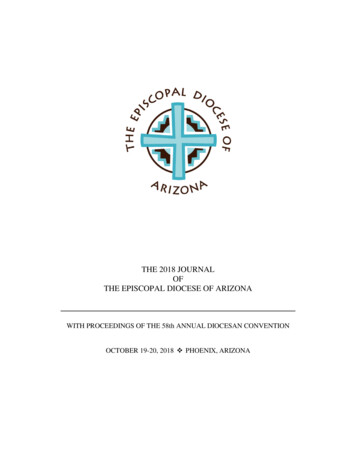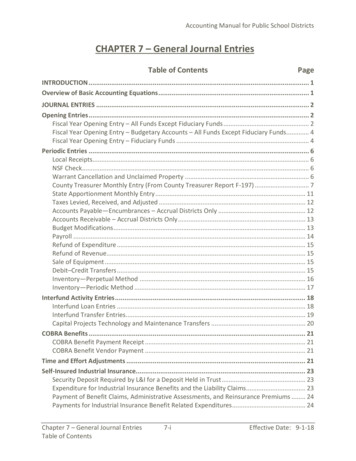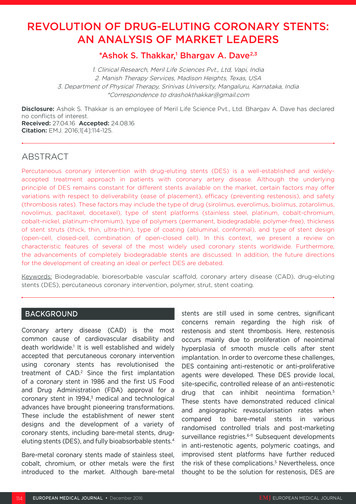
Transcription
THE 2018 JOURNALOFTHE EPISCOPAL DIOCESE OF ARIZONAWITH PROCEEDINGS OF THE 58th ANNUAL DIOCESAN CONVENTIONOCTOBER 19-20, 2018 PHOENIX, ARIZONA
Summary of Bishop’s Official Acts for 2018Confirmations . 127Receptions . 49House of Bishops . 2Letters Dimissory Received . 6Letters Dimissory Issued . 3Marital Judgements .12Ordinations to the Diaconate . 9Ordinations to the Priesthood . 5Celebration of New Ministries . 3Parochial Visits . .24Renewal of Ordination Vows.1Ordination into the Sacred Order of DeaconTara Bartholomew – St. Barnabas on the Desert, ScottsdaleDavid Chavez – Trinity Cathedral, PhoenixPatrice Cole – St Peter’s, Litchfield ParkKelli Joyce – St Philip’s In The Hills, TucsonAlison Lee – St Philip’s In The Hills, TucsonSusana Santibanez – St Andrew’s, GlendaleGary Sawyer – St Peter’s, Litchfield ParkAdrian Tubbs – St George’s, HolbrookTanya Watt – Trinity Cathedral, PhoenixOrdination into the Sacred Order of PriestDavid Chavez – Trinity Cathedral, PhoenixKelli Joyce – St Philip’s In The Hills, TucsonAlison Lee – St Philip’s In The Hills, TucsonDenise Muller, Trinity Cathedral, PhoenixSusan Santibanez – Trinity Cathedral, PhoenixClergy Who Have Died in the Past YearThe Rev Eugenia DurhamThe Rev Vergie FergusonThe Rev Ernie HarrelsonThe Rev Bradie HopperThe Rev Albert RichThe Rev Charles SmithThe Rev Donald TwentymanThe Rev Robert Williams
Parochial Visits in 2018 St Paul’s, WinslowSt Peter’s, Litchfield ParkGood Shepherd in the Hills, Cave CreekChrist the King, TucsonSt Stephen’s, PhoenixSt Andrew’s, SedonaSt Michael’s, TucsonChurch of the Advent, Sun City WestSt Thomas, ClarkdaleSt James the Apostle, TempeChurch of the Nativity, ScottsdaleSt Paul’s Sudanese Mission, PhoenixSt John’s, GlobeSt Mark’s, MesaSt John’s, WilliamsSt Raphael’s in the Valley, BensonSaint Barnabas on the Desert, ScottsdaleSt Alban’s, TucsonGrace Church, Lake Havasu CityAll Saints’ Church & Day School, PhoenixTrinity Cathedral, PhoenixSt Luke’s, PrescottChrist Church of the Ascension, Paradise ValleySt Anthony on the Desert, Scottsdale
Famous Last WordsAs I travel around the diocese during these last months as your bishop, someone often asks me thisquestion--”So bishop, do have any last words?” At first that struck me as a little morbid. When I think of“famous last words” I think the statements made by various celebrities on their deathbeds. Peopleseems to be very interested, for example, in the fact that Teddy Roosevelt's final words were “Pleaseput out the light,” or George Washington on his deathbed spoke to those around him “ ‘Tis well.”On the other hand, we sometimes joke about famous last words, statements that someone makes thatwe know won’t turn out to be true like: Don’t worry it's not that deep. Are you sure the power is off?I've seen this done on TV.But last words can be serious too, and I do have some last words for you as we gather for what will bemy last convention. I do have some final things to say as I think back upon our 15 years together inministry. They come in three parts. As we open convention, I want to focus on successes and challenges.Tonight, at what my I hope is not my “roast,” I want to take time to say thank you to so many withwhom I have worked. And finally tomorrow, as we gather around the Lord's table minutes before theDiocese elects a new bishop, I want to remind us all of God’s continuing presence with us.As we reflect for a few minutes on “the good the bad and the ugly, the achievements and failures of ourmutual ministry, I think that is important to review the assumptions and the philosophy behind specificprograms.You may have seen those old medieval paintings portraying the Holy Spirit as a dove whispering in theear of a gospel author, dictating to them what to write down. In my case there have been four modernthinkers who have especially inspired me in my Episcopal ministry. I have talked about them at previousconventions. They are my special mentors, heroes, and patron saints.The first is Claude Payne, the retired bishop of Texas. Before I was even consecrated in 2004, aparishioner gave me a copy of his book. Reclaiming the Great Commission. That book taught me howvital it is to be clear about the mission of the church. Our job is not to maintain the institution, but toproclaim the Good News, and everything we do in the church must reflect that purpose. Bishop Payneinsists that sharing Jesus’ is our “prime directive,” and we must not to be afraid to junk all those thingsthat get in the way of the goal. He focuses on Jesus’ words in the last verse of the Gospel of Matthewwhere Jesus tells us “to go unto all nations, preaching, and baptizing.” Jesus’ last word to us is not “sit”but “go” When we do that, Bishop Payne says, we can and should expect miracles. So the word I learnedfrom him is the mandate we have for mission--GO.Becoming a mission driven diocese has not been easy. Our budgets and our church culture are largelyself-serving, concerned more with keeping the lights on and the doors open than in reaching theunchurched. When I first challenged you to look beyond the four walls of your church buildings, many ofyou scratched your heads. But that has changed. Directing our attention and energy away our owninternal parish business and outwards towards others is not only necessary for growth but downrightexciting.This mission mandate on the diocesan level is reflected in several ways: We are one of 20 out of 110dioceses in the country which have shown grown, and we have planted more new congregations thanany other diocese in the country. Some of you may remember that at my first convention I gave you a
BHAG, big hairy audacious goal of 10 new congregations in 10 years. Well, it took us a little longer, butwe made it!That growth would not have been possible without terrific leadership by local clergy. An older and wiserbishop told me at my first house of bishop’s meeting that my most important job was to recruit greatclergy, and I took his words to heart. I was surprised to learn that there are only two rectors still in placein our 65 congregations from the time I started. Every other congregation has had a least once change inclergy leadership during that timeMy canons to the ordinary and I have always believed in what we call “guerrilla recruitment.” We don’tjust sit around waiting for a priest to apply for an opening. We actively recruit them, and you areenjoying the results.My next inspiring mentor has been Russell Crabtree, whose book “A Fly in the Ointment” reminded meof the necessity for any institution, especially churches, to remain focused on the needs of itscustomers. In the case of the diocesan staff, those customers are you, the clergy and lay leaders of yourparishes.Your customers in turn are the folks that sit in your pews. It is easy for a bishop and diocesan staff to bedistracted by extraneous matters. . But our job is to give you the resources you need so that you in turncan serve those in your local congregations. Our job is to make your job easier. This is such an importantconcept that we have made it our mission statement. The members of Dio staff literally wear it on theirSleevesWe exist to encourage and connect leaders as they grow Christ’s church.Existimos para animar y conectar lideres a medida que crecen la iglesia de Cristo.Making resources available to you as leaders is reflected in our philosophy of being an out the doordiocese. Our Sr staff members are on the road as much as I am, coming to you to support you in areas ofparish administration, finance, communication, youth and children’s work, and community involvement.We have created gatherings for training lay leaders, including our yearly lay leaders chapel rock retreat.The outstanding example is of course our Best Skills/ Best churches program. As most of you know, thisis a year long training event that earns one a certificate in nonprofit management from ASU. It started asa program for presbyters, but now offers a version for deacons and lay leaders as well. By the time theyear is over, more than 130 of you will have earned this diploma. But it is more than just something toput on the wall. I have seen the program bear fruit in the ways that congregations approach volunteerrecruitment, financial management, and conflict resolution. This program has been so popular that weexpect it will soon be making is debut in other dioceses around the country.One slogans I have borrowed from Russell Crabtree is “All Mission is local” and that thinking drives ourparish rebate program. This works by returning to you a portion of your mission share to be used for theevangelism and outreach projects in your community. One of the great joys I have each year is readingthe reports of the specific ways you do this.Another facet of mission to mention here is youth and children’s work. Crabtree points out that nearlyevery church in the country expresses a desire to attract and serve more young families. We can do that.As you may know, Arizona is the only diocese in the country which has two full time diocesan canons for
youth and for children. We also have four full time college chaplains with new partnerships with theLutheran church at NAU and ASU polytechnic. Thanks to support from the Neely Foundation, we arelooking to create a visiting professorship at ASU in the field of religion and culture to enrich theintellectual and spiritual lives of students there. All this in addition to providing ongoing support ofseveral parish youth professionals, as well as the outstanding programs offered at Chapel Rock eachsummer.This past summer a new week of camping was offered. Called Camp Genesis, and with scholarship helpfrom many of your congregations, we provided time away from home for children whose parents areincarcerated.My next inspiring thinker is James Davison Hunter In his book To Change the World he argues thatchurch’s need to reclaim the role they had in the 19th and early 20th centuries of being in partnershipwith community organizations and being actively engaged in the issues and problems of the localcommunity. We in the diocese used to do this. You may remember that we founded St Luke’s hospital inPhoenix, but sold it in the 1990s to a for-profit company because we didn’t want to be bothered with itsproblems. What a mistake. That is exactly where we should have been! But we are beginning to turnthat around by greater involvement with community agencies.Expanding our concern beyond our own congregations, the diocese has continued to be engaged inworking for just immigration policy and has provided help and support for those children separatedfrom their parents in the government’s recent cruel attempts to target families seeking asylum, To datewe have given several thousand dollars to this effort and some of you, both clergy and lay have beenactive on the border (offering?). It's been one of my great pleasures as bishop to have the chance towork with our ecumenical partners on border issues, which still remains the largest moral crisis we faceas a country. Not only my thinking, but also my spirit was changed by my time on the border.We are also entering into deeper partnerships with other churches to serve the spiritual needs of ourcommunities. We now have three churches and two campus ministries with our brothers and sisters inthe Evangelical Church of American, who by the way, just a few months ago elected their new 6thbishop, just as we will elect out 6th bishop tomorrow. A good omen, I think!My last hero is Alan Kreider. As I have been traveling around the diocese this past year, at the forumtime I have been sharing my enthusiasm about his new book. Krieder is a patristics scholar--he studiesthe writings of the earthy church, and the question he poses himself is, why did the early church grow soquickly, while Christianity today is in decline.His answer surprised me. Up until about 400 AD, the church had no money, no social standing, nobuildings and no Developed doctrine, yet it grew from 12 people to 5 million and became the dominantforce in the ancient world. What did they have that we don’t? It turns out they had a theology ofpatience, of prayerfully waiting upon God, and they had a counter-cultural lifestyle. They didn’t fit in likeeveryone else, they took unpopular stands--they were known for such things as praying in public, beinghonest in business dealings, taking care of the poor and sick, protecting women and children, refusing toserve in the army or participate in violent games, sharing their possessions with each other. Oddlyenough, when Christians were so unpopular that they were being exiled and killed is the same time inhistory when they gained the most converts. One of the early church fathers said, “Christians don’t say,read this, or believe this, they say, watch this. Watch the we share God’s love with the world.”
This means that we need to rethink the way we do church in the 21st century. The church can no longerbe in league with a materialist culture, or a comfortable part of the social establishment. and it mustreject even more strongly systems of government which are racist and repressive. If you were arrestedfor being a Christian would there be evidence to convict you? It’s a joke, yes, but the message is serious.We are not just like other people. Christians are different, and we must live out that difference.One way we can emulate the early church is to ways to support small local congregations who can’tafford full time clergy. We have lots of people called to do this, but they can’t leave their jobs andfamilies to go off the other side of the country for three years of residential training. The problem hasbeen finding a way to do to get them the formation they need which is comparable to the traditionalprogram. I am glad to say that we now have four postulants from places like Tombstone, Safford,Kingman, and Holbrook who are working with tutors from our diocese (all of whom have Ph.Ds.,) whowill become “tent-maker priests” In another very experimental move, we are also partnering with a fastgrowing downtown ecumenical church. Called Harbor church, it meets in a under-used Methodistchurch building and serves especially young urbanites. Their leaders will be introduced to you laterafternoon.These past fifteen years has been a time of great growth and accomplishments. But I don’t want you togo away thinking that I am blowing my own horn, or overlooking the contributions that all of you havemade to this progress. I also need to take a moment to look at the other side of the ledger page, thoseprojects and ideas which didn’t work so well. Some of these fails are mine, others we all share in theresponsibility for, but like all mistakes, we can learn from them.First lesson: Don’t try to build a baseball field. Sorry about that effort a few years ago, it seemed like agreat idea at the time, but we did get a nice green space at Chapel Rock.My other areas of concern are much more complicated. At a recent parish forum, someone asked methe question: “Bishop what keeps you up at night?”That’s easy. Our demographics as a church. Like most other Christians groups in this country, theEpiscopal church is geriatric. The average Episcopalian is 65 years old, and that might be even higher inArizona where we have so many retirees. Although many of our churches are full, when I ask myself as Ilook out from the altar, what would happen if every here who had grey hair, or was bald, left, how manywould be left in the pews? The result does not bode well for us. The former statistician for the Episcopalchurch, Kurt Hadaway, recently stated that as an institution we are facing what he called, a tsunami ofdeath, and that if present trends continue, the Episcopal church will cease to exist by the time mygrandson Lars is my age. We have, as I said, made some good progress in reaching younger families, butwe have a long way to go, and need to make reaching this age group the top of our priority list.That’s going to take some money to be sure, and this is another place we still need to step our game. Iam deeply grateful to the efforts of our Canon for Stewardship, Timothy Dombek to help congregationsgrow in this area. His Stewardship University (stew u) has gone national, and because of his efforts andyour generosity, the diocese, at least is in good financial shape. There are only two or three of ourcongregations who are unable to pay their full mission share, the lowest number in our history.But we still have a long way to go. Episcopalians are the richest Christian denomination in the country,over 60% of our households have an annual earning of over 100K, but we are third from the bottom
when it comes to giving. We are rich but cheap. You know the saying, you can’t take it with you, well weEpiscopalians seem to be trying pretty hard to do just that! If we are going to attract young families, thatmeans that we have to have things to offer them, and all of those things cost money, starting withpersonnel and programs designed to reach them.Here is an interesting statistic--Of the ten largest congregations in the country, 7 of them started as ayouth group. Here is another, in successful church plants, the second person added to the payroll is ayouth pastor. In the episcopal church that youth hire is more likely to come somewhere on the list rightafter the third assistant sexton. We can do this folks, we have a theology and a tradition of worship thatis very attractive to young people, but they won’t come if we treat them as an afterthought.So my friends, it has been quite a journey. There were emotional high points--like celebrating at theNational Cathedral on Arizona Day and visiting with Episcopal congregations in Ecuador, Taiwan, Spain.Eating Mutton stew in the Navajoland or Moose stew in Alaska, sharing tea and cake with Her Majestythe Queen at the Lambeth conference, or tortillas with immigrants seeking asylum south of our border.Ordaining a class of ten new deacons at the cathedral in Phoenix, confirming 55 Hispanic youth at StAndrew’s in Glendale, Listening to a Bach Cantata at All Saints in Phoenix on Good Friday, a livelymusical youth production of the Easter Vigil at St Barnabas. Being part of the house of bishops whenthey elected the first woman presiding bishop in 2006 and the first African American Presiding Bishop in2015.There have been down times too: Struggling to keep some of our congregations together at the time ofBishop Gene Robinson’s consecration. Dealing with feelings of anger and betrayal when a clergyperson's behavior necessitated their removal from a congregation. Trying to get Sheriff Arpaio's squadcars to move from blocking the entrance to San Pablo’s church. Having to say goodbye to friends movingto new places or burying clergy colleagues like Dick George, Bill Rhodes, Gordon McBride, Dan Gerrard,or Pam Mulac.But throughout this time I have been blessed in more ways that I can number--and that is a story fortonight. But the biggest blessing continues to be the evidence that I see that Holy Spirit is strongly atwork among you and among our brother and sister Episcopalians everywhere.We Arizona Episcopalians come from an ancient church steeped in tradition and history, and we live andwork in a new land, a desert full of both creativity and suffering. And yet Jesus Christ is the same,yesterday, today, and tomorrow, and it is he who will have the last word.But in the meantime, this then is my last word to you. In choosing it, I read over many quotable phrasesuttered by celebrities. And here is my favorite. It comes from Steve Jobs, founder of Apple.As I look over what has past and look forward to the future of diocese, I too sayOh wow, oh Wow, oh Wow
58thMinutes of theAnnual Diocesan Convention"TRANSITION: Looking to the Future”The Episcopal Diocese of Arizona at Work!All Saints’ Episcopal Church & Day School - Phoenix, ArizonaOctober 19-20, 2018Friday, October 19, 2018Call to OrderThe 58th Convention of The Episcopal Diocese of Arizona was called to order at 1:04 PM on Friday, October 19, 2018,by The Rt. Rev. Kirk S. Smith, Bishop of Arizona.Opening Prayer: Collect for ConventionBishop Smith offered the Opening Prayer and Collect for Convention.GreetingsBishop Smith asked the Secretary to Convention to send greetings to Bishop and Mary Carol Shahan.Introductions and AnnouncementsBishop Smith introduced the Diocesan Staff: The Rev. Canon Megan Traquair, Canon to the Ordinary The Venerable Sarah Getts, Archdeacon Canon Jana Sundin, Canon for Children’s Ministries Canon Jesse Villegas, Jr., Canon for Youth & Young Adult Ministries Canon Nicole Krug, Canon for Media and Communications & Diocesan Disaster Coordinator Canon Cathy Black, Canon for Administration & Assistant to Bishop Smith Bill Potts, Director of Finance and Property Sharon Graves, Safeguarding Administrator Roberta Hancock, Events Coordinator & Best Skills Best Churches Program Manager Jenifer Nguyen, Financial Assistant Dawn Jackson, Administrative Assistant to Canon for Administration Serrena Addal, ReceptionistBishop Smith introduced the Adjunct Staff: The Rev. Canon Timothy M. Dombek, Canon for Stewardship and Planned Giving The Rev. Canon Gil Stafford, Canon Theologian The Rev. Canon Martir Vasquez, Canon for Hispanic Ministries The Rev. Canon Debbie Royals, Canon for Native American Ministries The Rev. Robin Hollis, Director of Deacon Formation AcademyBishop Smith stated that there were no announcements to be made at this time.1
New Mission Celebration – Resurrection Episcopal Church, GilbertBishop Smith introduced The Rev. Scott Jones, Vicar, Resurrection Episcopal Church, Gilbert, and invited him to thestage. Calling upon members of his congregation to join him, Rev. Jones described to Convention the “wonderful,joyous struggle” of the past four years, which has culminated in this most inspiring moment – Resurrection’s seatingas a mission in the Diocese. Rev. Jones noted with a smile that in addition to beginning to pay a mission share,Resurrection also will be looking to acquire their own building in the near future. Bishop Smith expressed his thanksand appreciation and that of the Diocese to Rev. Jones and Resurrection’s leadership group, and Convention warmlywelcomed the Diocese’s newest mission with a standing ovation.Introduction of Harbor Church Missional Community, PhoenixBishop Smith informed Convention of a new missional initiative, a partnership with Harbor Church, a downtownPhoenix ecumenical church, under the leadership of husband and wife team, Dr. Cory Peacock (PhD, New YorkUniversity) and Dr. Amy Jacober (PhD, Fuller Theological Seminary). Bishop Smith noted that both Dr. Peacock and Dr.Jacober are well-known to the Diocese: Dr. Jacober being involved in conducting our tentmaker priest trainings, andboth she and Dr. Peacock having long been involved at Chapel Rock. Bishop Smith described that Harbor Church isreaching a demographic in downtown Phoenix that is in real need and that the Diocese is very pleased to join in thisexperimental partnership with them.Bishop Smith introduced Drs. Peacock and Jacober, and invited them to the stage. Dr. Jacober thanked Bishop Smithand the Diocese for their support and asked for continued prayers for Harbor Church’s efforts, as they minister tothose who have never heard the word of Jesus or who have been wounded by the church.Bishop Smith’s PresentationAs he has traveled the Diocese since announcing his retirement, Bishop Smith said, he has frequently been asked thisquestion: “Do you have any last words for us, Bishop?” Thus, he explained, he entitled his presentation toConvention, “Famous Last Words.” Looking back over his 15 years in this ministry and ahead to the future of theDiocese, Bishop Smith’s PowerPoint presentation noted three timeframes and topics: “Today: Famous Last Words;Tonight: Thank You, Thank You, Thank You!; and Tomorrow: Come, Holy Ghost.”Addressing Convention in the “Today,” timeframe, Bishop Smith shared the words and teachings of some of thoseinspiring mentors whose works have informed and impacted his ministry: Bishop Claude E. Payne, (“Reclaiming the Great Commission: A Practical Model for TransformingDenominations and Congregations,” co-author, Hamilton Beazley, Jossey-Bass (2000));J. Russell Crabtree, (“The Fly in the Ointment: Why Denominations Aren’t Helping their Congregations andHow They Can,” Church Publishing Incorporated (2008));James Davison Hunter, (“To Change the World: The Irony, Tragedy, and Possibility of Christianity in the LateModern World,” Oxford University Press (2010)); andAlan Kreider, (“The Patient Ferment: The Improbable Rise of Christianity in the Roman Empire, BakerAcademic (2016)).Bishop Smith highlighted experiences and examples from his 15 years as Bishop of the Diocese of Arizona, where hehas seen those teachings put into action, as well as describing his hopes for their continued impact and relevance.Bishop Smith noted the importance of Bishop Payne’s statement that our job is not to maintain the institution, but toproclaim the good news, and that sharing Jesus is our prime directive. Jesus’s last word to us isn’t, “Sit,” said BishopSmith; it’s to “Go!” This is vital to keep in mind, he said, as a mission-driven Diocese is not easy to maintain and it’s2
easy to become focused on such things as keeping the lights on. We must continue to direct our energies outwardtoward others, however, not inward toward our own parishes, he said. Arizona is one of only 20 Dioceses nationwidethat has shown growth, Bishop Smith informed Convention, meeting in just a little over the timeframe, the “Big,Hairy, Audacious Goal,” or “BHAG,” he set at the beginning of his tenure, to seed ten new congregations in ten years.Following J. Russell Crabtree’s basic directive, summarized as, “know your customers,” Bishop Smith pointed to thework of the Diocesan staff, who, he said, wear their mission on their sleeves: “We exist to encourage and connectleaders as they grow Christ’s church.” “All mission is local,” is another concept Bishop Smith told Convention he hasborrowed from Mr. Crabtree. Focusing on our young people, Arizona is the only Diocese that has two, full-timeCanons for children and youth ministries, Bishop Smith reported.From the work of James Davidson Hunter, Bishop Smith pointed to lessons we have learned from turning aroundmistakes, such as the sale of St. Luke’s in the 1990’s, but, moreover, to exemplifying the teaching, “Be partners forgood.” Our ongoing partnership with the Evangelical Lutheran Church of America, which, coincidentally, just electedits sixth Bishop, is a good example of that, said Bishop Smith, as is the offering that will be made tomorrow to benefitfamilies at the border.Distilling the message of Alan Kreider, Bishop Smith said, “Christians don’t say, ‘Read this,’ or ‘Believe this‘ – we say,Watch this!’” We must emulate the early church, which grew despite a lack of money, buildings, doctrine, or power.It grew because it had patience, hospitality, and a counter-culture lifestyle. We will never grow if we are just likeeverybody else. Bishop Smith reminded Convention of the saying, “If you were arrested and accused of being aChristian, would there be enough evidence to convict you?” We have programs, Bishop Smith noted, that recognizethat, like the early church, “small is beautiful;” programs like our tentmaker priests, serving rural areas of our state,and our new partnership with Harbor Church, ministering to the underserved downtown Phoenix community.In addition to being asked to share “last words,” Bishop Smith said that he often is asked, “What keeps you up atnight?” To that, he said, he would answer, “Demographics; Stewardship; and Core Values.” As to demographics,Bishop Smith stated that a former Episcopal statistician has said that the Episcopal Church is facing, “a tsunami ofdeath,” with the average age of an Episcopalian being 65 years old – which, in fact, may be even older in Arizona,Bishop Smith suggested.In the area of stewardship, Bishop Smith expressed gratitude to Rev. Canon Timothy M. Dombeck for his leadership of“Stewardship University,” or “Stew U.” Notwithstanding efforts such as that, Bishop Smith cited a statistic that 60% ofEpiscopalian households earn 100,000.00 or more per year, but that we are third from the bottom in terms of ourgiving. We are, it would seem, “rich, but cheap,” apparently seeking to defy the adage, “You can’t take it with you.”“It has been quite a ride,” Bishop Smith said of the past 15 years. The years have been filled with wonderfulhighlights, among them, travels all across the state of Arizona, attending inspiring youth productions, serving as amember of the House of Bishops, and sharing tortillas at the border
Summary of Bishop's Official Acts for 2018 . ear of a gospel author, dictating to them what to write down. In my case there have been four modern thinkers who have especially inspired me in my Episcopal ministry. I have talked about them at previous . Clarkdale St. Thomas 21 54,824 90,939 101,240 103,315











